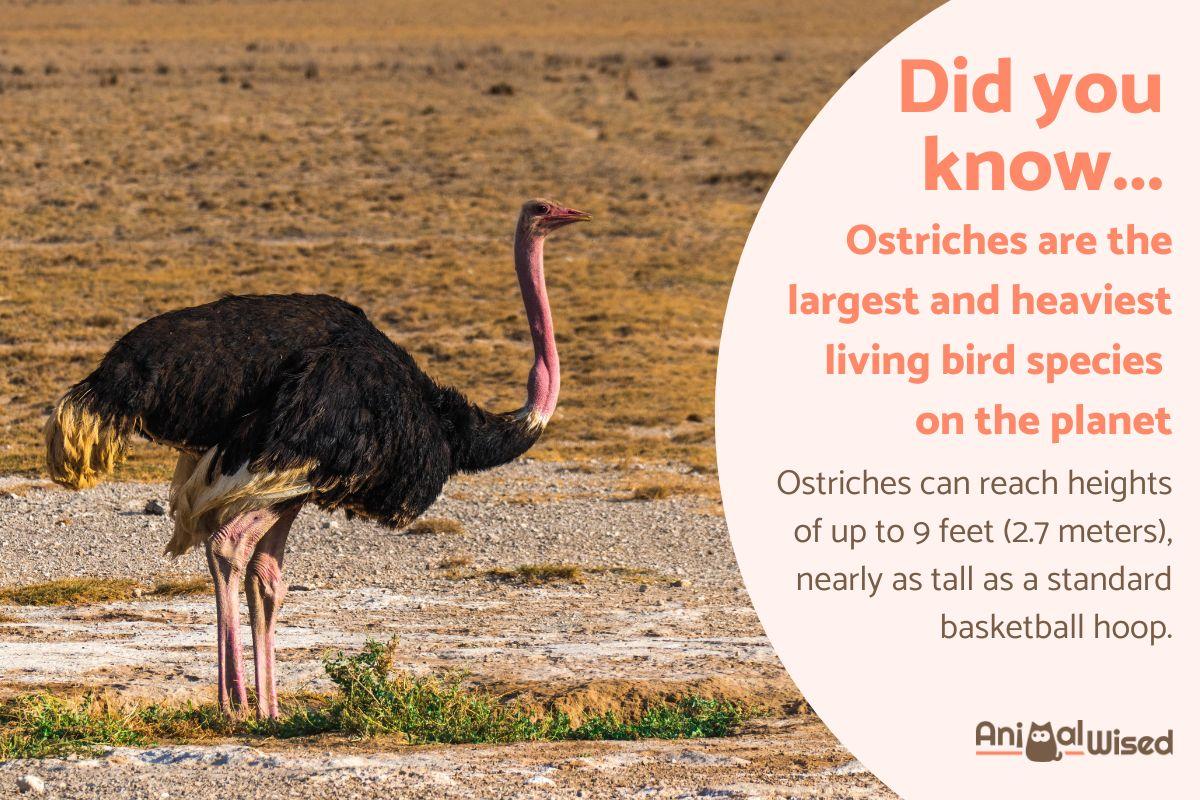10 Fun Facts Abut Ostriches


Ostriches are known for their long, slender necks. However, beyond their unique appearance, ostriches are intriguing creatures with a range of fascinating traits worth exploring. From their incredible running abilities to their social behaviors and remarkable adaptations for survival, ostriches offer a world of wonder in the animal kingdom.
Keep reading our AnimalWised article to discover 10 fun facts about ostriches that may surprise you.
- Ostriches are the largest flightless birds in the world
- Ostriches can run very fast
- Ostriches lay giant eggs
- Ostriches have a multifunctional stomach
- Ostriches communicate with sounds
- Ostriches have exceptional vision
- Ostriches camouflage for protection
- Ostriches are cooperative parents
- Ostriches are native to Africa and found in various regions
- Ostriches are long-lived animals
Ostriches are the largest flightless birds in the world
One of the key characteristics of ostriches relates to their size. Adult ostriches typically measure between 2.1 to 2.7 meters (6.9 to 8.9 feet) from the top of their heads to the ground. This is primarily due to their long and robust legs.
In terms of weight, adult ostriches generally fall within the range of 100 to 160 kilograms (220 to 352 pounds). As is common in many animal species, males are usually larger and heavier than females.
Another notable feature that distinguishes the ostrich as the largest flightless bird is its wingspan. While the ostrich's wings themselves are relatively small and not built for flying, their wingspan extends to approximately 1.8 meters (5.9 feet), and in some instances, even reaches 2.7 meters (8.9 feet).
For insights into the evolutionary reasons behind ostrich wings and their significance, delve into our article where we explain why ostriches have wings.
Ostriches can run very fast
Another intriguing characteristic that sheds light on the nature of ostriches is their remarkable capacity for high-speed running. This ability is a direct outcome of their adaptation to a terrestrial lifestyle. Ostriches have evolved to thrive on land, and their exceptional running skills serve as a crucial survival strategy. When faced with predators like lions or hyenas in their natural habitat, ostriches rely on their speed to increase their chances of escape.
So, just how fast can ostriches sprint? These flightless birds are capable of reaching speeds of up to 72 kilometers per hour (45 miles per hour). This astonishing pace allows them to outpace many of their natural adversaries and is a testament to their remarkable adaptations for life on the ground.
Make sure to explore our related article featuring a list of other flightless birds.

Ostriches lay giant eggs
When it comes to bird eggs, ostrich eggs stand out as truly exceptional. They hold the distinction of being the largest eggs among all living bird species. To put it in perspective, these eggs can be as sizable as a small melon or even a soccer ball.
On average, an ostrich egg measures approximately 15 to 18 centimeters (5.9 to 7.1 inches) in length and 13 to 15 centimeters (5.1 to 5.9 inches) in width, with a weight ranging from about 1.4 to 1.8 kilograms (3.1 to 4 pounds).
Adding to the intrigue, ostrich eggs possess an oval shape and are encased in a rough and thick shell. This shell is not only robust but also exceptionally hard and resistant, which is a noteworthy adaptation of these remarkable birds.
Ostriches have a multifunctional stomach
The term "polyfunctional stomach" refers to a specialized feature found in the digestive system of some birds, including ostriches. This particular stomach is often called a "gizzard." It plays a crucial role in the digestion of various foods these birds consume, which can range from plants to occasional insects and small animals.
This unique stomach structure allows ostriches to efficiently process their diverse diet, extracting essential nutrients. It's an important adaptation that helps them survive in environments with a wide range of food resources.

Ostriches communicate with sounds
Sound and communication play a noteworthy role in the world of ostriches, much like many other animals. Just as cats employ a myriad of sounds to convey their feelings and intentions, ostriches have their unique vocalizations for communication.
Ostriches may not be known for their chattering, but they do have an interesting repertoire of sounds, including:
- Roars: these deep and resonant calls can serve various purposes in their social interactions.
- Gurgling sounds: ostriches often make gurgling sounds, particularly during mealtime, expressing their satisfaction.
- Night howls: in response to feeling threatened or disturbed, ostriches may emit eerie night howls, alerting others to potential dangers.
- Clicks: these clicking sounds are part of their daily communication and may convey various messages within the ostrich community.
While they may not be the most talkative birds in the animal kingdom, these sounds are integral to their daily communication and play an essential role in their interactions and survival.
Ostriches have exceptional vision
One of the remarkable features of ostriches, driven by their need for survival and their adaptation to their environment, is their exceptional vision.
Delving deeper into this fascinating aspect, we find that ostriches possess binocular vision, much like humans. This means that they can focus on objects using both eyes simultaneously, enabling them to perceive depth and distances accurately.
In addition to their binocular vision, ostriches boast an expansive field of view that covers nearly 360 degrees around them. This wide field of vision is crucial for detecting potential predators in their surroundings, allowing them to remain vigilant and responsive to threats.
Remarkably, ostriches are also capable of perceiving a range of colors, including red, green, and blue. This ability is vital for identifying various foods and objects within their environment.
Moreover, ostriches' eyes are well-equipped for low-light conditions. With large eyes, eyelids, and eyelashes, they can maintain excellent vision even in dim lighting situations.
Ostriches camouflage for protection
Survival is at the heart of the ostrich's daily life, and while they may not be renowned for these traits, they employ a range of effective camouflage techniques to thrive in their environment.
Ostriches sport feathers that range in color from brown to gray, a natural palette that seamlessly blends with the soil and surrounding vegetation in their habitat. This innate coloration serves as a valuable form of camouflage, making them less conspicuous to potential predators.
When it comes to protecting their offspring, ostriches go to great lengths. They construct nests on the ground and often camouflage them meticulously with stones, vegetation, and earth. This not only shields the eggs and chicks from prying eyes but also enhances their chances of survival.
In moments of perceived threat, ostriches exhibit a unique form of self-preservation. They become motionless and crouch to the ground, effectively transforming themselves into what appears to be a nondescript mound or bush rather than a conspicuous bird. This clever immobility strategy acts as a form of camouflage, allowing them to avoid detection by potential threats.
Ostriches are cooperative parents
Ostriches are renowned for their social nature, particularly when it comes to breeding. It's quite a distinctive characteristic among birds, as not many species engage in such extensive parental care involving both adults.
In the world of ostriches, it's not uncommon to witness several adults cooperating in incubating and caring for the eggs and newly hatched chicks. This cooperative effort significantly enhances the survival prospects of the young ostriches. This communal approach to parenting is indeed unique in the avian kingdom.
As we've explored various aspects of ostrich behavior in this article, their cautious and ever-alert nature comes to the forefront. This constant vigilance plays a crucial role in protecting the nest and young. Having both parents present near the nest and the offspring serves as a deterrent to potential predators, providing an extra layer of defense.
Moreover, both ostrich parents actively participate in the incubation of the eggs. This ensures that the hatchlings receive ample nourishment and essential lessons on foraging and surviving in their environment. The commitment of both parents to their young underscores the ostrich's remarkable social and parental instincts, contributing to the success and resilience of these fascinating birds.
For further insight into unique parenting behaviors in the animal kingdom, delve into our article on top worst parents in the animal kingdom.

Ostriches are native to Africa and found in various regions
Ostriches primarily inhabit the continent of Africa, and their distribution spans a vast range of regions within the continent. These remarkable birds are typically found in semi-arid areas and continental savannahs, characterized by open landscapes with scattered vegetation.
They can be found in various African regions, including West Africa (such as Senegal and Chad), East Africa (including Kenya and Somalia), Southern Africa (like Zambia and Mozambique), and Central Africa (including countries like Cameroon and the Central African Republic).
This broad distribution reflects the adaptability of ostriches to a range of African environments, where they have evolved to thrive and survive.
Ostriches are long-lived animals
In the wild, the lifespan of ostriches is subject to various factors like food availability, predator presence, and weather conditions. On average, ostriches in their natural habitat have a lifespan ranging from approximately 30 to 40 years.
In contrast, ostriches in captivity, such as those found on breeding farms and in zoos, often enjoy a longer life expectancy. The controlled environment shields them from natural predators and ensures a more consistent supply of food and access to veterinary care. Under these conditions, some captive ostriches can live well into their 50s or even reach the age of 60.
Don't miss this other article where we explain the distinctions between a rhea and ostrich.
If you want to read similar articles to 10 Fun Facts Abut Ostriches, we recommend you visit our Facts about the animal kingdom category.








